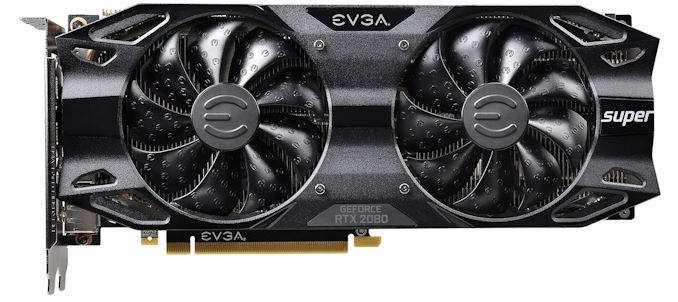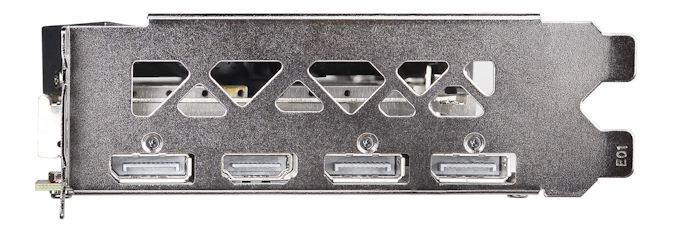EVGA Announces GeForce RTX 2070 Super KO & RTX 2080 Super KO
by Gavin Bonshor on April 10, 2020 8:00 AM EST
Expanding its series from its first KO graphics card in years, EVGA unveiled its GeForce RTX 2060 KO at CES 2020, which made waves as was one of the first non-reference GTX 2060 cards to be released at $299. Continuing to fight the good fight for users looking for value from within the latest models, EVGA has released two new models in its KO series, the GeForce RTX 2070 Super KO, and the GeForce RTX 2080 Super KO.
Back at CES 2020, EVGA released its first KO series card since the GeForce 9800 GTX era with the ray-tracing enabled GeForce RTX 2060 KO. The primary aim was on offering users a card with many of EVGA's bells and whistles, but at a solid entry-level price point. Building on that, the new EVGA GeForce RTX 2070 Super KO and RTX 2080 Super KO follows on as the successor to the equally good value for money EVGA GeForce RTX Black models.
Some of the most prominent features of the new EVGA RTX Super KO models include a dual-slot, dual-fan cooler, with both models following the same black-themed design of the Super Black Gaming series. And, in what seems like a welcome rarity these days, there is no RGB LED lighting of any kind, which some users may prefer.
Opening up with the beefier of the two cards, the EVGA GeForce RTX 2080 Super KO has the same specifications as the RTX 2080 Super Founders Edition. This includes a base GPU clock speed of 1650 MHz, with a boost clock of 1815 MHz. Memory speeds remain the same at 15.5 Gbps, and the same 8 GB of GDDR6 over a 256-bit memory bus.
The cheaper EVGA GeForce RTX 2070 Super KO also shares the same specifications its reference counterpart, the RTX 2070 Founders Edition. This means the RTX 2070 Super KO has an effective memory clock of 14 Gbps, a base core clock of 1605 MHz which boosts to 1770 MHz.
Both models share the same design throughout, with its dual-slot twin fan cooler, albeit bereft of a backplate for visually appealing aesthetics and extra cooling on the rear of the cards VRMs. Looking to the I/O, both share the same set of outputs including triple DisplayPort 1.4 outputs, with a single HDMI 2.0b video output. On paper, the only major difference in performance between the new Super KO and Founders Edition models is the custom cooler, with EVGA employing a fairly similar design overall to NVIDIA's.
The EVGA GeForce RTX 2080 Super KO has an MSRP of $699 with a $10 rebate available to bring it in line with reference model pricing. Cheaper still is the GeForce RTX 2070 Super KO which is available for $499 with users also able to benefit from a $10 instant rebate from EVGA. Both models can be purchased directly from the EVGA online store, or at Amazon and Newegg.


















37 Comments
View All Comments
drexnx - Saturday, April 11, 2020 - link
it's not just computer companies that use this kind of marketing either - i.e. another product whose key demographic is 20something men, sportbikes and use of the letter "R"ZX-6R/RR, CBR600RR, R6, GSX-R600, etc.
more R = moar betterer!
Koenig168 - Friday, April 10, 2020 - link
Was excited to learn there are going to be new KO models. Read the article and found that it is just FE with a custom cooler. bleah.QChronoD - Saturday, April 11, 2020 - link
Does the HMDI 2.0b support 4k120 with VRR?nevcairiel - Saturday, April 11, 2020 - link
No, HDMI 2.0 does not have enough bandwidth for a proper 4K120 experience. You may be able to use with with YCbCr 4:2:0, but thats such a visual downgrade for gaming that I would not recommend it to anyone.erinadreno - Saturday, April 11, 2020 - link
I wonder if they would use ultra binned-down version of TU102 as 2060KO uses TU104 die.And oddly enough, they don't seem to have a Type-C port for saving 10$ presumably.
timecop1818 - Saturday, April 11, 2020 - link
No type-c, no sale. Even the reference 2080/2070 have one. This gives one more displayport output, which is actually useful.Qasar - Saturday, April 11, 2020 - link
but, its use is for VirtualLink, which is for VR headsets, may not be usable as a alt-mode display output. sorry timecop1818, but it looks like you might be wrong in assuming it can be used as another display port outputerinadreno - Saturday, April 11, 2020 - link
Well about that, I can confirm it does support display alt mode. VR Link might have some display over USB packets stuff, but I haven't read anything about that.timecop1818 - Sunday, April 12, 2020 - link
What, virtuallink is just another alt-mode extension and DisplayPort alt-mode is also supported just fine, I've used it and the great part about it being standard is that it just works.Flunk - Saturday, April 11, 2020 - link
So I guess we're not getting the next-gen Nvidia cards for a while.